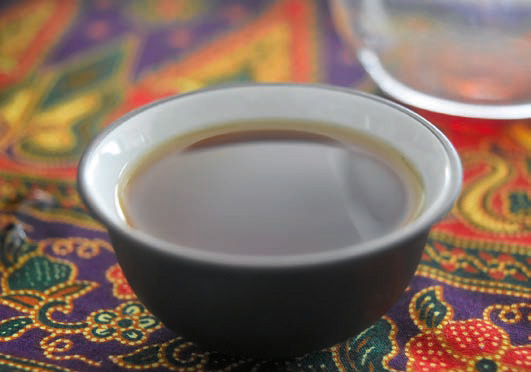Tea and everyday life: observations from Chaoshan, Guangdong
<p>What place do the rich traditions of Chinese tea culture hold in the everyday lives of people in a fast-changing, increasingly consumerist society? To explore this question, I travelled to a region renowned for its traditional tea culture: the Chaoshan (潮汕) region in eastern Guangdong province, home of <em>gongfu </em>tea – one of the most elegant and refined of China’s diverse tea-drinking traditions. Through in-depth, informal interviews, and observations over several trips to Chaozhou and other centres in Chaoshan, I tried to understand what <em>gongfu </em>tea meant for people in Chaoshan. [qtip:1|d'Abbs, P. 2017. <em>Art as Everyday Practice: A Study of Gongfu Tea in Chaoshan, China.</em> Master of Arts with Honours, University of New England, Armidale, NSW.]</p><div> <hr align=\"left\" size=\"1\" width=\"33%\"><div id=\"edn1\"><p> </p></div></div>
The first finding that became apparent to me was how deeply gongfu tea was integrated into the everyday lives of people of all kinds of social background. As one of my interviewees explained, it has ‘seeped into our bones’. People who were born and raised in Chaoshan did not consciously learn about gongfu tea, they simply came to know about it as they grew up. The integral place of gongfu tea had three dimensions: spatial, temporal and social. Spatially, gongfu tea was everywhere. In the workplaces, shops or homes that I observed, a gongfu tea set was always found in regular use. Temporally, gongfu tea is woven into the rhythms of everyday life: at home, after dinner; and in shops, whenever trading is slow, out comes the gongfu tea set. Above all, drinking gongfu tea can be considered to be a social activity, nurturing relationships with family, friends and associates, and in doing so, affirming the drinkers’ identity in a network of social relationships through which a distinctive and valued regional culture is transmitted.
As literary descriptions tell us, gongfu tea is a highly refined way of preparing and drinking tea, using small teapots, preferably of Yixing or Chaozhou clay, or porcelain gaiwan, in which to prepare a very strong brew, most frequently of the locally grown, semi-fermented Fenghuang Dancong (鳳凰單叢) tea. This is poured into small cups of around 30 ml capacity for drinking repeated infusions from the same tealeaves. From my observations, preparing and drinking gongfu tea requires attentiveness to procedural details – to being jiangjiu (講究) – but this was achieved, not by slavishly following a rigid sequence of steps as some literary accounts suggest, but by showing skill and dexterity. A gongfu tea-drinking occasion creates its own tempo. Regardless of whether the occasion lasts ten minutes or two hours, during this time participants put aside the incessant demands for haste that punctuate the world around and appreciate the tea slowly.
For most of my research participants, drinking gongfu tea was seen as “part of our lives”. Some participants, however, had chosen to elevate their tea-drinking to a kind of art. Again, this was accomplished by cultivating expertise and discernment in one or more of several domains, for example, creating a special space for drinking tea; seeking out high quality tea utensils; exploring philosophical and spiritual aspects of tea-drinking; developing a capacity to understand and appreciate the qualities and properties of any given tealeaves, and knowing where and how to purchase teas of the finest quality.
Today’s globalised world is characterised by what some sociologists have described as transnational streams of ‘cultural capital’, in which cultural objects from one place are appropriated, redefined and repackaged for deployment as commodities elsewhere. 2 In the case of Chaoshan gongfu tea, it is possible to detect at least three such ‘streams’. Firstly, within China, gongfu tea modelled on Chaoshan practices has been taken up by many non-Chaoshan people, particularly in business settings, as a vehicle for interacting and negotiating with associates. Secondly, in the emergence of contemporary tea art in Taiwan that began in the 1970s, a style of drinking adapted from Chaoshan gongfu tea came to be regarded not as one among many regional styles in China, but as Chinese tea art per se. 3 Thirdly, outside China gongfu tea is being promoted as an authentic, national Chinese ‘tea ceremony’, by implication analogous to the well-known Japanese tea ceremony, with cultural roots that go back to ancient times. This last claim is bolstered by historically dubious suggestions that Chaoshan gongfu tea is a modern manifestation of Tang dynasty tea-drinking practices as described by Lu Yu in the oldest extant treatise on tea, the Cha Jing or Classic of Tea. (In fact, gongfu tea almost certainly originated in the 18th century in the Wuyi mountain area of Fujian province.)
Where these cultural streams will flow in future is a question for another day. In the meantime, in at least one region of China, traditional tea culture continues to enrich the lives, not just of a privileged cultural elite, but of people everywhere.
Peter d’Abbs is Professorial Research Fellow, School of Public Health, University of Queensland, Australia. (p.dabbs@uq.edu.au)
